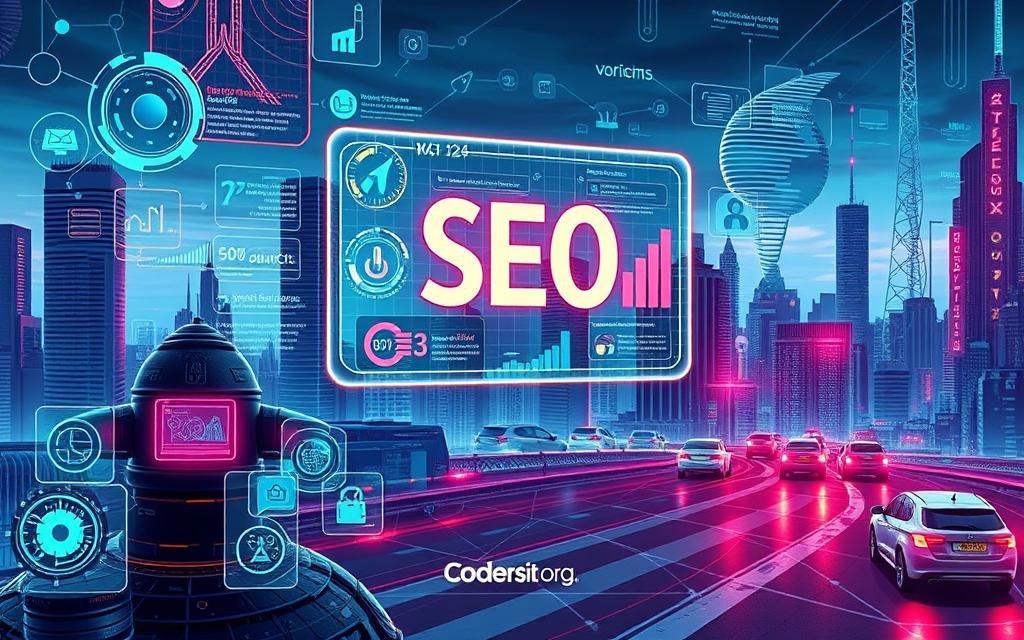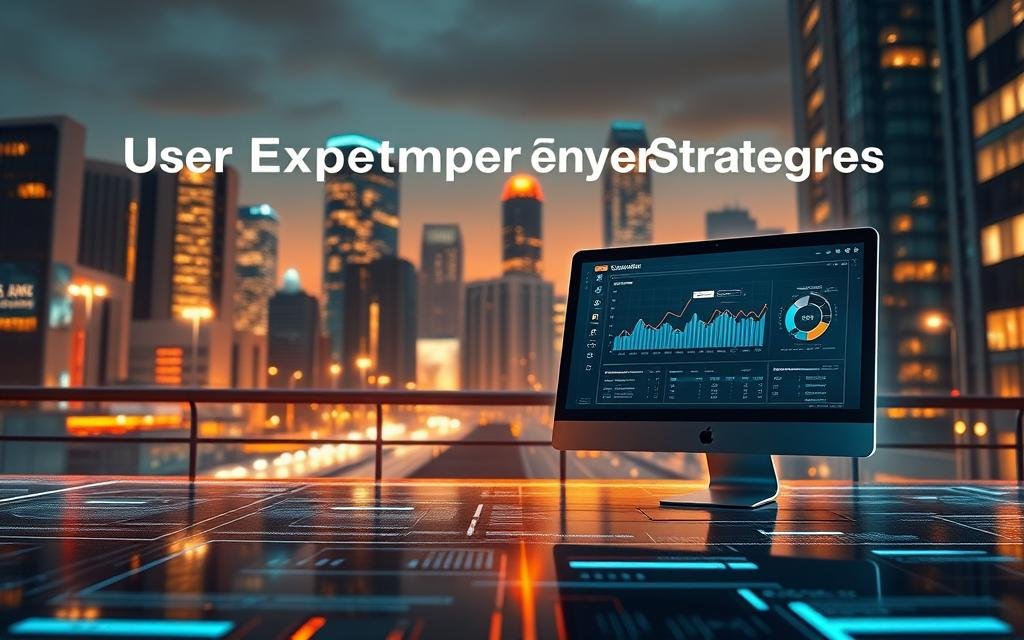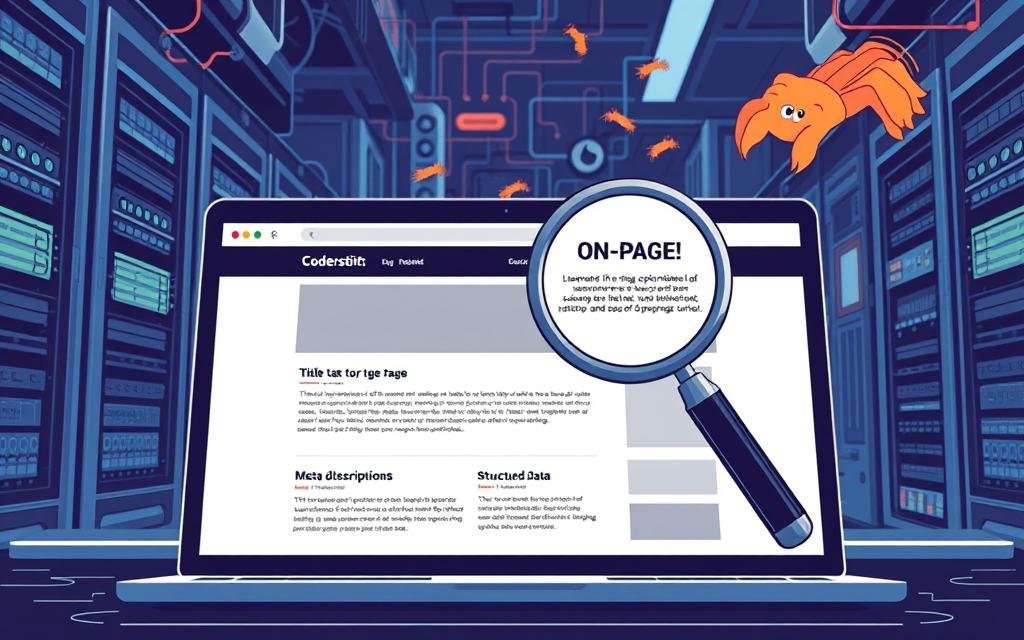In 2025, standing out online isn’t just a goal—it’s a necessity. With billions of websites competing for attention, businesses need strategies that align with how search engines operate. Automated crawlers scan the web daily, prioritizing sites that deliver value, relevance, and seamless user experience. If your content isn’t optimized, it risks getting buried.
Google’s Search Essentials highlight the shift toward quality-first principles. Algorithms now prioritize pages that load quickly, answer questions clearly, and adapt to mobile users. This isn’t just about technical tweaks—it’s about building trust with both visitors and search engine systems.
Modern SEO blends creativity with data. For example, a well-structured blog post might rank higher if it includes multimedia, avoids jargon, and addresses user intent. Brands that ignore these updates risk losing organic traffic to competitors who adapt.
This guide breaks down the latest tactics, from metadata optimization to content clustering. You’ll learn how to create pages that search engines love while keeping audiences engaged. Let’s dive in.
Key Takeaways
- SEO remains critical for visibility as search algorithms grow more sophisticated.
- Automated crawlers prioritize websites with fast load times and clear content.
- User experience directly impacts rankings, including mobile optimization and readability.
- Google’s guidelines emphasize E-E-A-T (Experience, Expertise, Authoritativeness, Trustworthiness).
- Balancing technical SEO with high-quality content drives sustainable growth.
Introduction to SEO in the Modern Digital Era
Digital visibility now depends on understanding how search algorithms interpret human needs. Over 90% of online experiences start with a query, and platforms prioritize results that align with real-time intent. This shift demands strategies blending technical precision with audience-centric creativity.

Today’s Search Optimization Landscape
Search engines now evaluate pages through layered criteria. Google’s helpful content update, for example, rewards sites prioritizing depth over keyword density. Tools like natural language processing analyze context, not just phrases. Brands must balance structure with substance—think schema markup paired with conversational FAQs.
Staying Agile in a Shifting Ecosystem
Adaptability separates leaders from laggards. When voice search surged, optimized sites saw 35% more traffic by restructuring content into concise answers. Regular audits ensure compatibility with core updates, while semantic keyword targeting captures emerging queries. One e-commerce brand boosted conversions 22% by aligning product descriptions with local search trends.
Success hinges on merging data with empathy. As one Google engineer noted, “Algorithms mirror human curiosity.” By crafting content that educates first and sells second, businesses build lasting relevance in crowded digital spaces.
The Evolution of SEO and Its Relevance in 2025
The digital landscape has transformed dramatically since the days of keyword stuffing and directory submissions. Early strategies focused on gaming search engines, but modern approaches prioritize user needs and technical precision. This shift reflects how algorithms now reward value over shortcuts.

Trends Shaping the SEO Industry
AI now powers everything from content creation to ranking analysis. Tools like ChatGPT help businesses generate FAQs that match real user queries. Mobile-first indexing means 60% of website traffic comes from smartphones—sites not optimized for small screens lose visibility instantly.
Technical optimizations like Core Web Vitals separate leaders from competitors. A 2024 case study showed a travel site boosting organic traffic 40% by improving mobile load speeds. Structured data markup also plays a bigger role, helping engines understand context beyond keywords.
Lessons from Past SEO Strategies
Early 2000s tactics prioritized quantity over quality. Today, Google penalizes thin content and rewards depth. For example, a finance business regained top rankings by rewriting 300-word articles into 1,500-word guides with expert citations.
Voice search and zero-click results forced brands to rethink keyword targeting. Instead of chasing single terms, winners now cluster topics around user intent. As one analyst noted, “Optimizing for questions beats guessing phrases.”
SEO is Essential: Driving Organic Search Success
In today’s digital race, securing a top spot in search results isn’t accidental—it’s strategic. Brands that consistently rank well understand how search engines prioritize relevance and authority. A 2024 study by BrightEdge revealed pages optimized for user intent generate 3x more traffic than generic content.

Fundamentals of Organic Traffic Growth
High-quality content remains the backbone of visibility. For example, a tech blog increased monthly visitors by 50% after rewriting product reviews to address common troubleshooting questions. Google’s data shows pages answering specific questions earn 50% more clicks than generic posts.
Authority signals like backlinks and domain reputation also shape rankings. A fitness brand partnered with medical experts to co-author guides, resulting in a 35% boost in organic traffic within six months. Trustworthy sources signal value to both users and algorithms.
| Factor | High Authority Site | Low Authority Site | Impact on Traffic |
|---|---|---|---|
| Content Depth | 1,200+ words with citations | 300-word summaries | +42% engagement |
| Backlink Quality | Links from .edu domains | Spammy directory links | +28% ranking stability |
| Page Speed | >4 seconds load time | +60% lower bounce rate |
Focusing on user experience drives long-term success. Pages with clear headings and bullet points keep people engaged 40% longer, according to NNGroup research. Tools like AnswerThePublic help identify real queries, allowing brands to craft content that matches what users type into search bars.
Enhancing User Experience Through SEO Best Practices
A well-structured website acts like a digital concierge—guiding visitors effortlessly while signaling value to search crawlers. Research shows 53% of users leave pages that take over 3 seconds to load, and 61% struggle to find content on cluttered sites. Prioritizing both speed and clarity creates wins for audiences and algorithms.

Streamlining Navigation and Performance
Fast-loading pages keep visitors engaged. Google’s 2024 study found sites scoring 90+ on Core Web Vitals retain users 2.5x longer. Mobile responsiveness is non-negotiable—over 60% of searches happen on phones. Simplify menus with logical hierarchies. For example, an outdoor gear brand reduced bounce rates by 28% after reorganizing product categories into intuitive groups.
| Factor | Optimized Site | Non-Optimized Site | User Impact |
|---|---|---|---|
| Load Speed | 1.8 seconds | 4.5 seconds | +40% engagement |
| Navigation Depth | 2 clicks to content | 5+ clicks | +33% page views |
| Mobile Design | Responsive layout | Desktop-only | +55% longer sessions |
Crafting Readable, Scannable Content
Break text into digestible chunks. Use subheadings every 2-3 paragraphs and bullet points for lists. A health blog saw a 22% traffic boost after reformatting articles with bold keywords and short sections. Tools like Hemingway Editor help maintain 8th-grade readability—critical for retaining diverse audiences.
Balance visuals with white space. Case studies reveal pages with images placed between text blocks keep users scrolling 30% longer. As one designer noted, “Clean design isn’t empty—it’s purposeful.” Pair aesthetics with function by linking related pages internally, creating pathways that satisfy curiosity and crawlers alike.
Embracing AI and Technology in SEO Strategies
Artificial intelligence reshapes how businesses connect with audiences online. Tools powered by machine learning analyze search patterns faster than humans, uncovering hidden opportunities. This shift allows brands to predict trends and refine strategies in real time.

Smart Tools for Smarter Decisions
Advanced algorithms now handle complex tasks like keyword clustering and intent mapping. For example, a travel website boosted rankings by 27% using AI to group related terms like “budget tropical vacations” and “affordable beach resorts.” These systems identify gaps in content while suggesting topics users actually search for.
| AI Tool | Function | Impact |
|---|---|---|
| Semantic Analyzers | Detect content relevance | +35% engagement |
| Predictive Search Models | Forecast trending queries | 22% traffic increase |
| Personalization Engines | Tailor user experiences | 18% conversion lift |
Personalization drives deeper connections. Streaming platforms like Netflix use similar tech to recommend shows—a tactic adaptable to websites. By serving localized information based on visitor history, brands keep users engaged longer.
One e-commerce store reduced bounce rates 40% after implementing AI-driven product recommendations. As a tech leader noted, “Machines spot what eyes miss.” Blending these innovations with traditional methods creates unbeatable experiences.
Technical SEO and On-Page Optimization Tactics
Behind every high-ranking webpage lies invisible groundwork that search crawlers rely on. Google’s data reveals mobile-friendly sites rank 50% higher in local searches, while pages loading under 2 seconds retain 70% more visitors. These technical details separate contenders from leaders.

Optimizing Meta Tags, Alt Text, and Headers
Title tags and meta descriptions act as digital business cards. A 2024 Search Console analysis showed pages with keyword-rich headers earned 40% more clicks. Use alt text to describe images clearly—travel sites using phrases like “sunset over Bali beach” saw 30% higher image search traffic.
Headers organize content for both readers and algorithms. Break articles into H2/H3 sections every 200 words. For example, a cooking blog improved dwell time by 25% after structuring recipes with ingredient lists and step-by-step instructions.
Ensuring Mobile-Friendliness and Fast Load Times
Over 60% of searches happen on phones. Google’s Mobile-Friendly Test tool flags issues like oversized images or cramped buttons. Fixing these boosted one retailer’s conversions by 18% in three months.
Compress files and leverage browser caching. A tech news site reduced load time from 4.2 to 1.8 seconds using WebP images, resulting in 35% fewer bounces. Tools like PageSpeed Insights provide actionable fixes.
| Factor | Optimized | Not Optimized | Impact |
|---|---|---|---|
| Structured Data | Product schema markup | No markup | +22% rich snippets |
| Canonical Tags | Proper duplicate handling | Missing tags | 35% less crawl waste |
Regular audits catch issues early. One SaaS company found 120 broken links during a quarterly check—fixing them recovered $12k in monthly leads. As a Google engineer noted, “Crawlers reward those who make their job easier.”
Structuring Your Website for Maximum Search Visibility
A website’s architecture acts as its backbone, guiding both users and crawlers to valuable content. Organized structures help search engines index pages faster while improving visitor navigation. Over 70% of top-ranking sites use clear hierarchies, according to a 2024 Ahrefs study.

Designing Logical URL Structures and Directories
Simple, descriptive URLs signal content relevance. For example, “/mens/sneakers” outperforms “/category123” by 33% in click-through rates. E-commerce giants like Amazon group products under intuitive paths like “/electronics/headphones,” making it easier for crawlers to map relationships.
Directories should mirror user journeys. A cooking site might organize recipes by meal type and dietary needs. This approach reduced bounce rates by 24% for one publisher. Avoid nesting pages too deeply—three clicks to content is the sweet spot.
Utilizing Breadcrumbs and XML Sitemaps
Breadcrumbs enhance navigation and clarify page relationships. Retailer Best Buy saw a 19% drop in exit rates after adding trail links like “Home > TVs > 4K Models.” These also create internal linking opportunities, boosting ranking signals.
| Structure Feature | Optimized Approach | Impact on Ranking |
|---|---|---|
| URL Clarity | /blog/digital-marketing-tips | +27% click-through |
| Breadcrumbs | Text-based navigation trails | 15% lower bounce rate |
| XML Sitemap | Updated weekly | 40% faster indexing |
XML sitemaps act as roadmaps for crawlers. Walmart reported 30% improved crawl efficiency after streamlining its sitemap. Pair this with HTML sitemaps for users—a dual strategy that satisfies bots and visitors.
As Google’s John Mueller notes, “Structure turns chaos into crawlable content.” By aligning technical foundations with user needs, businesses secure lasting visibility in competitive web environments.
Building Authority with Quality Content and Credibility
Trust remains the cornerstone of digital influence in competitive markets. Brands that consistently deliver original insights gain recognition as leaders in their industry. A 2024 HubSpot study found websites updating content quarterly earn 65% more backlinks than those publishing sporadically.

Developing Unique, Up-to-Date Content
Expert-driven articles outperform generic posts by addressing niche questions. For example, a cybersecurity firm increased organic traffic 47% after hiring engineers to write technical guides. Google’s systems prioritize fresh perspectives—outdated statistics or broken links can drop rankings overnight.
| Content Strategy | High Authority Approach | Impact on Rankings |
|---|---|---|
| Update Frequency | Refresh key pages twice annually | +33% visibility |
| Expert Contributions | Industry professionals co-author posts | 28% more shares |
| Citations Used | Link to .gov or .edu sources | 19% higher trust signals |
Clear citations and data-backed claims build credibility. A finance blog citing Federal Reserve reports ranks #1 for 12+ competitive keywords. Avoid fluff—readers and algorithms favor actionable advice over vague statements.
Continuous improvement separates leaders. One media company audits top-performing articles monthly, adding new case studies and trimming redundant sections. This approach boosted their domain authority by 14 points in six months. As a content strategist noted, “Authority isn’t claimed—it’s earned through relentless refinement.”
Capturing Local Audiences with Local SEO Techniques
Over 46% of Google searches seek local information, from store hours to service areas. Businesses that tailor their online presence to nearby customers often dominate search engine results, driving both clicks and foot traffic. Local strategies bridge the gap between digital visibility and real-world engagement.
Optimizing Your Google Business Profile
A complete Google Business Profile acts as a digital storefront. Start by verifying business details—name, address, and phone number (NAP). Add photos of products, staff, and your location. Use keywords like “emergency plumbing services in [City]” to align with common google search queries.
Regularly post updates about promotions or events. Enable messaging to answer questions instantly. A bakery in Austin saw 30% more weekend visits after adding daily specials to their profile. Profiles with 100+ photos get 42% more requests for directions, per Google data.
Implementing Local Citation and Review Strategies
Citations on directories like Yelp and Yellow Pages reinforce legitimacy. Ensure your NAP matches exactly across platforms. Inconsistent listings confuse search engine crawlers and customers alike. A hardware store in Denver boosted visibility 40% by fixing mismatched addresses.
| Citation Factor | High-Quality Profile | Low-Quality Profile | Local Ranking Impact |
|---|---|---|---|
| NAP Consistency | Matches across 50+ sites | Varies by platform | +35% visibility |
| Review Responses | Reply within 24 hours | No engagement | 28% trust increase |
| Star Rating | 4.7+ average | Below 3.5 | 2x more clicks |
Encourage reviews by sending post-purchase emails. A moving company gained 120 five-star reviews in three months, landing them in the “local pack” for 15 keywords. Respond professionally to negative feedback—it shows accountability and can improve search results positioning.
Measuring SEO Performance with Analytics and Tools
Tracking progress separates thriving websites from stagnant ones in today’s digital arena. Tools like Google Analytics and Search Console reveal what’s working—and what’s not. By analyzing real-time data, businesses adapt strategies to meet evolving search engine standards while staying ahead of competitors.
Setting Up Tracking Systems
Start by linking Google Analytics to your site. Verify ownership in Search Console to access crawl reports and indexing status. Enable enhanced metrics like scroll depth and video engagement to gauge content effectiveness. For example, a recipe blog discovered 60% of users abandoned pages without video tutorials—prompting them to add step-by-step clips.
Key Metrics That Matter
Focus on three core areas: organic search traffic, session duration, and goal completions. Pages with 2+ minute average engagement often rank higher due to positive user signals. Conversion paths show how visitors move from blog posts to product pages.
| Metric | Tracking Tool | Benchmark | Optimization Impact |
|---|---|---|---|
| Organic Search Traffic | Search Console | 10% MoM growth | Adjust meta tags |
| Bounce Rate | Google Analytics | <45% | Improve content relevance |
| Social Referrals | Cross-channel reports | 15% of total traffic | Boost platform-specific content |
Combine keyword research data with social media insights. If Instagram drives 30% of your traffic, align blog topics with trending hashtags. A fashion retailer increased newsletter sign-ups 25% by creating content matching Pinterest search trends.
Regular audits prevent strategy drift. One tech firm updates their dashboard weekly, spotting algorithm shifts 43% faster than industry averages. As a marketing director noted, “Data doesn’t lie—it redirects.”
Integrating SEO into Broader Digital and PR Strategies
Modern brands thrive when their digital efforts work in sync, not in silos. Aligning search optimization with social media, PR, and content marketing creates campaigns that amplify visibility across channels. This unified approach drives measurable outcomes—from higher website traffic to stronger reputations.
Harmonizing Strategies for Maximum Impact
Social media insights reveal what people search for organically. A skincare brand noticed TikTok trends around “sensitive skin remedies” and optimized blog content accordingly. This synergy boosted organic clicks by 34% and social shares by 19%.
| Strategy | Integrated Approach | Isolated Approach | Result Difference |
|---|---|---|---|
| Content Promotion | Blog + Instagram Reels | Blog Only | +48% Engagement |
| Link Building | Guest Posts + PR Outreach | Directory Submissions | 2x More Backlinks |
| Keyword Use | Social Listening + SEO | Generic Keywords | 27% Traffic Increase |
Building Authority Through Collaboration
Partnering with industry blogs or influencers builds credibility. A finance firm co-created a report with a university, earning links from .edu domains. This lifted their engine results ranking for 12 competitive terms.
Data-Driven PR Messaging
SEO also guides PR teams. Analyzing top-performing keywords helps craft press releases that align with public interests. A tech startup used search data to highlight “AI privacy tools” in media pitches, landing coverage in 8 major outlets.
Metrics like click-through rates refine campaign focus. One nonprofit adjusted donation appeals after finding 65% of website traffic came from “climate change volunteer” searches. Their next fundraiser exceeded goals by 22%.
Conclusion
Sustainable growth in 2025 demands more than just online presence—it requires strategic alignment with search dynamics. Businesses that combine technical precision, audience-focused content, and local optimization build lasting visibility. From structured data to mobile-first design, every detail shapes how platforms and users perceive value.
Adaptability remains critical. Search algorithms evolve rapidly, rewarding brands that prioritize fresh insights and seamless experiences. Integrating these efforts with social media and PR amplifies reach, turning organic traffic into measurable outcomes like leads and sales.
Forward-thinking businesses treat optimization as a continuous process. Regular audits, keyword refinement, and cross-channel collaboration ensure relevance amid shifting trends. The strategies outlined here offer a roadmap—not shortcuts—for thriving in competitive markets.
As voice search and AI reshape discovery, one truth endures: those who align with user needs today will dominate rankings tomorrow. Start refining your approach now to secure a future where visibility equals opportunity.

Pingback: How SEO Services Can Improve Your Online Visibility and Drive Sales
In 2025, SEO remains crucial for business success due to the growing dominance of digital platforms. As consumer behavior shifts more online, having a strong search presence ensures that businesses are discoverable when potential customers search for products or services. Investing in SEO in 2025 isn’t just about traffic—it’s about building sustainable, future-proof digital growth.
Very well explained .
This guide is incredibly detailed and easy to understand! I appreciate how you broke down complex SEO strategies into actionable steps, especially for small businesses like mine. The sections on search intent and local SEO were particularly insightful. Thanks for sharing such valuable information — definitely bookmarking this for future reference!”